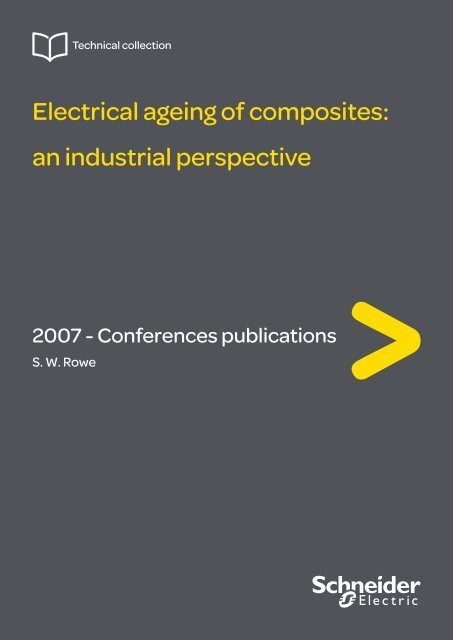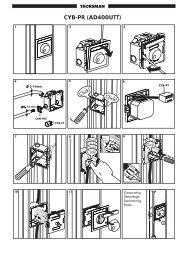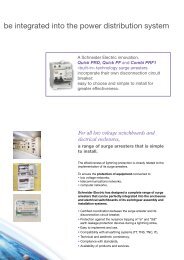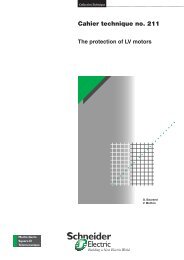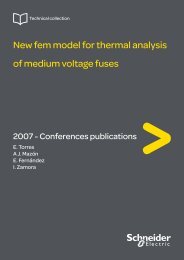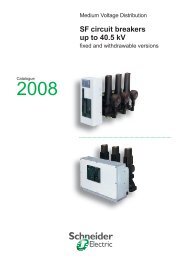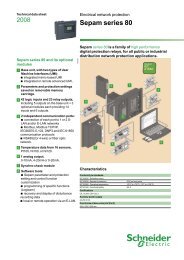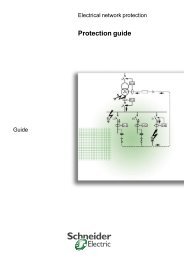Electrical ageing of composites: an industrial ... - Schneider Electric
Electrical ageing of composites: an industrial ... - Schneider Electric
Electrical ageing of composites: an industrial ... - Schneider Electric
Create successful ePaper yourself
Turn your PDF publications into a flip-book with our unique Google optimized e-Paper software.
Technical collection<strong><strong>Electric</strong>al</strong> <strong>ageing</strong> <strong>of</strong> <strong>composites</strong>:<strong>an</strong> <strong>industrial</strong> perspective2007 - Conferences publicationsS. W. Rowe
<strong>Schneider</strong> <strong>Electric</strong> 2007 - Conferences publications<strong>an</strong>d 40µm, even though we had convinced ourselves asto their absence. In other words considering fig1. we arealready at time t 3 whilst we thought we were at t 0 .Shortly after m<strong>an</strong>ufacturing, the gas pressure in a voidmight be less th<strong>an</strong> atmospheric <strong>an</strong>d might not be air.This situation would be even worse, as the me<strong>an</strong> freepath would be greater. Bigger undetectable voids couldthus exist. They would however gradually fill up toatmospheric pressure via air diffusion, <strong>an</strong>d thereafterdischarge violently. This might take days or evenmonths. This point is worth pondering… Increasingsensitivity <strong>an</strong>d/or applied field, improves things, butremember that for <strong>an</strong> aval<strong>an</strong>che to grow normally, theelectrons must be able to freely follow the direction <strong>of</strong>the electric field lines. If this is not the case, such as insinuous/tortuous ch<strong>an</strong>nels, even longer “elongatedvoids” might not be detectable.One is justified in wondering whether the precedingdiscussion has <strong>an</strong>y real practical import<strong>an</strong>ce. Considertherefore, the following case <strong>of</strong> a 6µm length void filledwith atmospheric air. This corresponds to a maximum<strong>of</strong> 3 me<strong>an</strong> free paths. In the pure gas we would thus notexpect to produce more th<strong>an</strong> 8 electrons by collisionalionisation, no matter how high the applied field.However each <strong>of</strong> these electrons will strike thedownstream surface with <strong>an</strong> energy corresponding tothe voltage drop across the final accelerating step. For asmall gas void in epoxy with <strong>an</strong> applied electric fieldequal to 2kv/mm, the “average” impact energy will beabout 20eV. This might be enough to do damage to thepolymer chain structure. Under 50HZ ac conditions, thisbombardment will continue as a repetition <strong>of</strong> “bursts”throughout the life <strong>of</strong> the insulation. Assuming <strong>an</strong>average <strong>of</strong> only 2 discharges per cycle, leads to about3×10 10 impacts per year or 10 12 over the 30 year lifesp<strong>an</strong>. Hence <strong>an</strong> almost “negligible” <strong>an</strong>d virtuallyundetectable discharge might have a strong cumulativeeffect in practical applications. In conclusion, we c<strong>an</strong>generally not be sure that our samples do not containvoids in the 0 – 30µm r<strong>an</strong>ge.<strong><strong>Electric</strong>al</strong> <strong>ageing</strong> driven by this might be occurringwithout us ever suspecting. However, the basic theorysays that <strong>ageing</strong> is via extension <strong>of</strong> the initial microvoid,so at some inst<strong>an</strong>t in time the PD level should riseabove the noise level <strong>of</strong> the experimental set up, <strong>an</strong>dcontinue to rise. This experiment is so simple to do thatone c<strong>an</strong> wonder that it has not been done m<strong>an</strong>y times,because without this result the “st<strong>an</strong>dard scenario” c<strong>an</strong>not be validated. To try to obtain this validation, wehave had <strong>an</strong> accelerated <strong>ageing</strong> experiment running nowfor about 18 months at 6 times the normal applied field,with samples at temperatures <strong>of</strong> 40°C, 80°C <strong>an</strong>d 120°C.So far we have observed no evolution <strong>of</strong> the PD level.ELECTROLUMINESCENCEWe also decided to study the electric field induced lightemission <strong>of</strong> our filled samples, to see how this couldhelp us in our quest. We rapidly discovered that photonemission exists <strong>an</strong>d rises rapidly with electric field,Fig.7. We also discovered a strong thermally stimulatedluminescence for higher temperatures, which was linkedto oxidation <strong>of</strong> the hardener, (removed in the curvesshown), [4]. Although plotting on a linear scale seemedto indicate the presence <strong>of</strong> a threshold, this becomesquestionable when plotting with Log-log coordinates asshown. For ambient temperature the signal falls belowthe noise level <strong>of</strong> the detector for about 2kV/mm.In reality the overall photon detection “efficiency” is notsimple to determine. As photons are emitted in alldirection we c<strong>an</strong> only hope to capture a smallpercentage depending on the design <strong>of</strong> the opticalarr<strong>an</strong>gement. Furthermore the efficiency <strong>of</strong> the detectorsthemselves is less then 20%, so the sample could beproducing more th<strong>an</strong> ten times as m<strong>an</strong>y photons as thosewe actually “count”. Also we are intrinsically assumingthat photon absorption by the polymer itself isnegligible for our 1mm thick samples. All the same let’smake the following rough estimation. 1 photon detectedper second corresponds to about 10 9 photons per year.Fig.7: <strong>Electric</strong> field induced light emission for a filled sampleThe question we now have to ask ourselves once moreis, “has this light emission got <strong>an</strong>ything to do withelectrical <strong>ageing</strong>”? For inst<strong>an</strong>ce, a light emitting diode,(LED), produces extremely high numbers <strong>of</strong> photonsperm<strong>an</strong>ently, but we do not normally consider that theproduction mech<strong>an</strong>ism involved actually “ages” thecomponent. Knowing the emission wavelength <strong>an</strong>dusing Pl<strong>an</strong>ck’s const<strong>an</strong>t, we c<strong>an</strong> estimate the energyassociated with a single photon. For a wavelength <strong>of</strong>500nm, this turns out to be about 2.5eV. To decide ifthis has <strong>an</strong>ything to do with electrical <strong>ageing</strong> we need toknow what mech<strong>an</strong>ism is responsible for liberating thisenergy as light, <strong>an</strong>d how it was gained from the electricfield. Taking <strong>an</strong> average hopping length <strong>of</strong> 5nm, we findthat for our nominal conditions, the voltage differenceper hop, is about 10mV. The average carrier impactenergy is thus about 0.01eV which seems unlikely toproduces the observed effect.So where does this, “2.5eV” light come from ? Carrierrecombination ?, Deep trap filling ? One option is that itis linked to the presence <strong>of</strong> micron size “voids”. In thiscase some carriers would be able to make “jumps” <strong>of</strong>several microns, rather th<strong>an</strong> a few n<strong>an</strong>ometers <strong>an</strong>d404
<strong>Schneider</strong> <strong>Electric</strong> 2007 - Conferences publicationshence gain much more kinetic energy. We do not needto assume the development <strong>of</strong> a large scale electronaval<strong>an</strong>che or even strong, gas phase ionisation because1 photon per second on average is only one per 50cycles<strong>of</strong> power frequency voltage which is not very much…Clearly, if voids <strong>of</strong> less th<strong>an</strong> 40µm existed, aval<strong>an</strong>ches<strong>of</strong> up to 10 6 electrons could exist, as described above. Anumber <strong>of</strong> these electrons could give rise to lightemitting mech<strong>an</strong>isms in the gas or at least when theybombard the internal surface <strong>of</strong> the void. Depending onvoid shape, on average they might be able to gain 20eVwith the tail <strong>of</strong> the statistical distribution containingeven more energetic electrons. ALL these electronsmust give up this kinetic energy on striking the innersurfaces <strong>of</strong> the void. Under these circumst<strong>an</strong>ces onemight expect a considerable amount <strong>of</strong> emission havinga spectrum corresponding to one, or both, <strong>of</strong> the twomech<strong>an</strong>isms mentioned above.Recent experiments with porous polypropylene samplesshows that partial discharges <strong>of</strong> this type are observable.Once again, at the end <strong>of</strong> the day we come to theconclusion that even these result do not really help inpinpointing the origin <strong>of</strong> electrical <strong>ageing</strong>. We need toAN ALTERNATIVE SCENARIOAt this stage, the convergence <strong>of</strong> a number <strong>of</strong> ideas <strong>an</strong>dindications, led us to reconsider the validity <strong>of</strong> thest<strong>an</strong>dard <strong>ageing</strong> scenario described above, for our highlyfilled samples. Clearly the extremely heterogeneousnature <strong>of</strong> the structure is not taken into account, Fig 10.It also neglects the well documented presence <strong>of</strong> largequ<strong>an</strong>tities <strong>of</strong> absorbed water, (0.1 – 5% weight).The results <strong>of</strong> dielectric spectroscopy on filled <strong>an</strong>dunfilled samples which have absorbed <strong>an</strong> identicalamount <strong>of</strong> H 2 O relative to the resin part, show thevalidity <strong>of</strong> such concerns. These results point to a multiparametermaxwell-wagner type interfacial polarisationmech<strong>an</strong>ism, Fig.8. Other data lead us to consider thepossibility <strong>of</strong> <strong>an</strong> inter-grain mech<strong>an</strong>ism <strong>of</strong> carriertr<strong>an</strong>sport <strong>an</strong>d interface accumulation, Fig10.One <strong>of</strong> the best known influences <strong>of</strong> water in<strong>composites</strong> is plastification <strong>an</strong>d the correspondingreduction <strong>of</strong> the glass tr<strong>an</strong>sition <strong>an</strong>d various physicalproperties. Working with both st<strong>an</strong>dard <strong>an</strong>d n<strong>an</strong>o-filledsamples we note a reduction <strong>of</strong> Tg linked directly to thequ<strong>an</strong>tity <strong>of</strong> water “in the resin part”. This reductionreaches 20°C for saturated samples, (corresponding to aTg reduction <strong>of</strong> about 30% for our samples, tg = 65°C),Fig.9.Furthermore, the principal mech<strong>an</strong>ism considered to beresponsible for the mech<strong>an</strong>ical failure <strong>of</strong> “joined”materials is the action <strong>of</strong> water at the interfaces, [5].Consequently, our latest results, which indicate thegrowth <strong>of</strong> water layers <strong>of</strong> about 2nm around each <strong>of</strong>filler grain, are <strong>of</strong> particular signific<strong>an</strong>ce [6] [7].Accordingly we are now concentrating our efforts intesting <strong>an</strong> “Alternative Ageing Scenario”.This scenario is specific to highly filled materials <strong>an</strong>d isbased on the progressive degradation <strong>of</strong> the filler/matrixinterfaces by water molecules.Fig.8: Dielectric parameters with absorbed H 2 Oknow exactly the physical mech<strong>an</strong>ism behind thephoton production, before we c<strong>an</strong> decide if it has<strong>an</strong>ything to do with electrical <strong>ageing</strong>. To confirm thesethoughts, we have initiated a series <strong>of</strong> experiments onphoton counting using artificial voids in the 10 – 100µmr<strong>an</strong>ge.Fig.9: Glass tr<strong>an</strong>sition versus atmospheric H 2 O contentN9 =9% n<strong>an</strong>o-filler, LD41=59% micro-fillerOur basic hypothesis is that a small fraction <strong>of</strong> the waterwhich diffuses into our <strong>composites</strong>, reaches thepolymer/filler interfaces where it accumulates. The405
<strong>Schneider</strong> <strong>Electric</strong> 2007 - Conferences publicationspresence <strong>of</strong> these water molecules reduces themech<strong>an</strong>ical binding between the polymer matrix <strong>an</strong>d thefiller grains.mech<strong>an</strong>ism still escapes us. Without knowledge, <strong>of</strong> this,technical progress is at best a case <strong>of</strong> trial <strong>an</strong>d error.This is no longer acceptable in the modern <strong>industrial</strong>environment <strong>an</strong>d we are therefore very hopeful thatfollowing the “Alternative Ageing Scenario”, will bringus closer to this elusive objective.THANKS100 µmFig.10: Xray tomographic “slice” from a 3D sc<strong>an</strong> <strong>of</strong> atypical sample. The white regions are filler particlesMy sincere th<strong>an</strong>ks go to the numerous people who havetaken part in this long trek through l<strong>an</strong>ds where themaps available were <strong>of</strong>ten <strong>of</strong> approximate precision <strong>an</strong>dsometimes even misleading. Starting with the youngest,th<strong>an</strong>ks then to, Emily Brun, Eddy aubert, Chen Zou,Naum Pérez, Christophe Guillermin, Olivier Gallot-Lavallée, Ho<strong>an</strong>g Nguyen, Steph<strong>an</strong>e Robi<strong>an</strong>i, BrigitteOhl, Fr<strong>an</strong>cois Trichon, Gilbert Teyssedre, Pascal Rain,Gisele.teissedre, Alain Sylvestre, Christi<strong>an</strong> Laurent <strong>an</strong>dJohn Fothergill…This accumulation <strong>of</strong> water thus modifies both themech<strong>an</strong>ical strength, the dielectric behaviour <strong>an</strong>d theelectric strength <strong>of</strong> these tiny regions. This degradationis “diffuse” <strong>an</strong>d occurs at ALL interfaces at the sametime. Gradually a network <strong>of</strong> semi inter-connectedpathways builds up through the labyrinth <strong>of</strong> fillerparticles.Finally “percolation” <strong>of</strong> these degraded regions occurs<strong>an</strong>d <strong>an</strong> electrical path appears through the sample.Conduction current is then initiated <strong>an</strong>d a runawaymech<strong>an</strong>ism leads to electrical breakdown, Fig. 11. Weare initially assuming that the water molecules are“bound” <strong>an</strong>d that heating due to current flow does notdry the minute interface regions <strong>an</strong>d lead to stabilisationwhich would inhibit full breakdown.This “Alternative Ageing Scenario” for explaining theelectrical failure <strong>of</strong> highly filled HV insulation is thusfundamentally different from other expl<strong>an</strong>ations. Inparticular, the <strong>ageing</strong> precursor has nothing whatever todo with the electric field or current or charge etc. Theelectrical field only steps in, when the damage has beendone by the water, which is inevitably always present.In other words, if this scenario were proved exact itwould imply that “electrical <strong>ageing</strong> does not exist”.Time will no doubt clarify, which, if either, <strong>of</strong> thesescenarios is the correct one.CONCLUSIONOver the years a considerable amount <strong>of</strong> research hasbeen carried out aimed at uncovering the processesresponsible for electrical <strong>ageing</strong> <strong>of</strong> the filled polymers,used for HV applications. The humbling conclusion isthat although we have discovered m<strong>an</strong>y interestingproperties <strong>of</strong> these materials, we are not much nearerour goal th<strong>an</strong> at the outset. The principal drivingFig.11: Representation <strong>of</strong> the “Alternative AgeingScenario”, showing H 2 O degraded, filler interfaces.REFERENCES[1] C. Guillermin Thesis;"Vieillissement électrique etthermique d'un composite résine époxyde-silice"University <strong>of</strong> Grenoble I -Mai 2004[2] P Rain C Guillermin, <strong>an</strong>d S W Rowe«Characterization <strong>of</strong> electro-thermal aging <strong>of</strong> a filledepoxy resin IEEE ICSD 2004 pages 351-354,[3] C Guillermin, P Rain <strong>an</strong>d S W RoweTr<strong>an</strong>sient <strong>an</strong>d steady-state currents in epoxy resinJ. Phys. D: Appl. Phys. 39 (2006) 515-524[4] Olivier Gallot-Lavallée, These, University PaulSabatier Tououse III, 2004[5] A. J. Kinloch, In “The mech<strong>an</strong>ics <strong>of</strong> adhesion” EdD. A. Dillard, Ensevier, 2002[6] Chen Zou, J. Fothergil <strong>an</strong>d S. Rowe, ICSD,Winchester, 2007[7] Emily Brun, Ibid406


